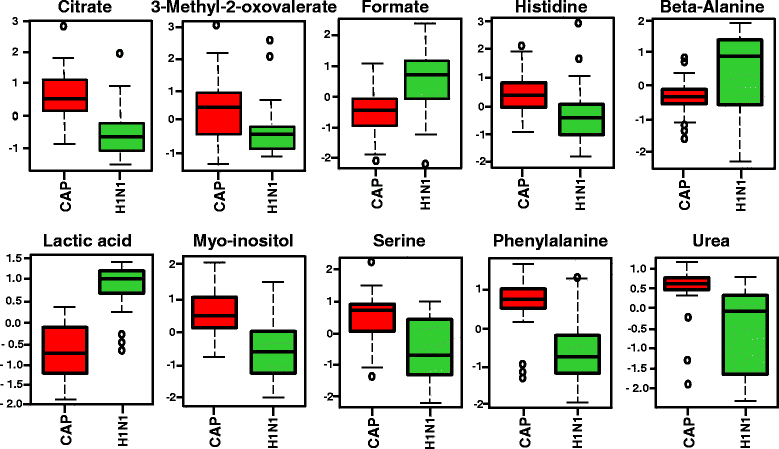Plasma metabolomics for the diagnosis and prognosis of H1N1 influenza pneumonia
- PMID: 28424077
- PMCID: PMC5397800
- DOI: 10.1186/s13054-017-1672-7
Plasma metabolomics for the diagnosis and prognosis of H1N1 influenza pneumonia
Abstract
Background: Metabolomics is a tool that has been used for the diagnosis and prognosis of specific diseases. The purpose of this study was to examine if metabolomics could be used as a potential diagnostic and prognostic tool for H1N1 pneumonia. Our hypothesis was that metabolomics can potentially be used early for the diagnosis and prognosis of H1N1 influenza pneumonia.
Methods: 1H nuclear magnetic resonance spectroscopy and gas chromatography-mass spectrometry were used to profile the metabolome in 42 patients with H1N1 pneumonia, 31 ventilated control subjects in the intensive care unit (ICU), and 30 culture-positive plasma samples from patients with bacterial community-acquired pneumonia drawn within the first 24 h of hospital admission for diagnosis and prognosis of disease.
Results: We found that plasma-based metabolomics from samples taken within 24 h of hospital admission can be used to discriminate H1N1 pneumonia from bacterial pneumonia and nonsurvivors from survivors of H1N1 pneumonia. Moreover, metabolomics is a highly sensitive and specific tool for the 90-day prognosis of mortality in H1N1 pneumonia.
Conclusions: This study demonstrates that H1N1 pneumonia can create a quite different plasma metabolic profile from bacterial culture-positive pneumonia and ventilated control subjects in the ICU on the basis of plasma samples taken within 24 h of hospital/ICU admission, early in the course of disease.
Keywords: Biomarkers; GC-MS; H1N1 pneumonia; Metabolomics; NMR.
Figures






Similar articles
-
Metabolomic Profile of ARDS by Nuclear Magnetic Resonance Spectroscopy in Patients With H1N1 Influenza Virus Pneumonia.Shock. 2018 Nov;50(5):504-510. doi: 10.1097/SHK.0000000000001099. Shock. 2018. PMID: 29293175
-
Procalcitonin levels are lower in intensive care unit patients with H1N1 influenza A virus pneumonia than in those with community-acquired bacterial pneumonia. A pilot study.J Crit Care. 2011 Apr;26(2):201-5. doi: 10.1016/j.jcrc.2010.07.009. Epub 2010 Sep 1. J Crit Care. 2011. PMID: 20813489
-
Discriminant biomarkers of acute respiratory distress syndrome associated to H1N1 influenza identified by metabolomics HPLC-QTOF-MS/MS platform.Electrophoresis. 2017 Sep;38(18):2341-2348. doi: 10.1002/elps.201700112. Epub 2017 Aug 25. Electrophoresis. 2017. PMID: 28714069
-
IgM levels in plasma predict outcome in severe pandemic influenza.J Clin Virol. 2013 Nov;58(3):564-7. doi: 10.1016/j.jcv.2013.09.006. Epub 2013 Sep 18. J Clin Virol. 2013. PMID: 24076102
-
[ARDS and influenza A (H1N1): patients' characteristics and management in intensive care unit. A literature review].Ann Fr Anesth Reanim. 2010 Feb;29(2):117-25. doi: 10.1016/j.annfar.2009.12.026. Epub 2010 Feb 8. Ann Fr Anesth Reanim. 2010. PMID: 20116970 Review. French.
Cited by
-
A metabolomic-based biomarker discovery study for predicting phototherapy duration for neonatal hyperbilirubinemia.Transl Pediatr. 2022 Dec;11(12):2016-2029. doi: 10.21037/tp-22-637. Transl Pediatr. 2022. PMID: 36643669 Free PMC article.
-
Evaluating Causal Relationship Between Metabolites and Six Cardiovascular Diseases Based on GWAS Summary Statistics.Front Genet. 2021 Oct 15;12:746677. doi: 10.3389/fgene.2021.746677. eCollection 2021. Front Genet. 2021. PMID: 34721534 Free PMC article.
-
Metabolic profiles in community-acquired pneumonia: developing assessment tools for disease severity.Crit Care. 2018 May 14;22(1):130. doi: 10.1186/s13054-018-2049-2. Crit Care. 2018. PMID: 29759075 Free PMC article. Clinical Trial.
-
Discovery and predictive modeling of urine microbiome, metabolite and cytokine biomarkers in hospitalized patients with community acquired pneumonia.Sci Rep. 2020 Aug 7;10(1):13418. doi: 10.1038/s41598-020-70461-9. Sci Rep. 2020. PMID: 32770049 Free PMC article.
-
Infection Biomarkers Based on Metabolomics.Metabolites. 2022 Jan 19;12(2):92. doi: 10.3390/metabo12020092. Metabolites. 2022. PMID: 35208167 Free PMC article. Review.
References
MeSH terms
LinkOut - more resources
Full Text Sources
Other Literature Sources
Medical
Molecular Biology Databases
Miscellaneous

